McMurdo Station in Full Swing
By Elizabeth Delaquess, McMurdo Station correspondent
December 20, 2018
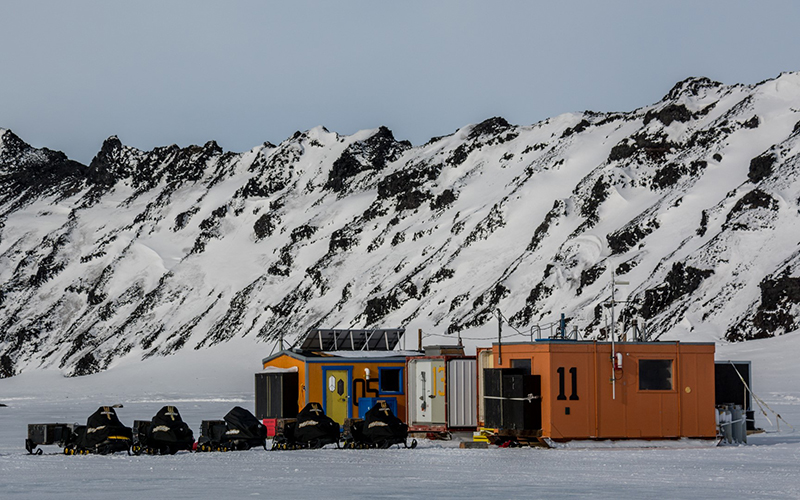
Photo Credit: Mike Lucibella
Researchers camped on the sea ice at Big Razorback are studying the population dynamics of Weddell Seals.

Photo Credit: Mike Lucibella
The first LC-130 of the season arrived on the continent on November 9th.
In spite of the delay at the start of the summer season, science and support were well under way by the end of November. Most summer workers arrived in mid-to-late October, following a two-week delay in Christchurch. In addition to bringing in hundreds of grantees and contractors and increasing McMurdo Station's population by several hundred in just a few days, the last members of the winter crew of McMurdo Station departed for Christchurch, some leaving the station after a full year on The Ice. The first small plane flights to Amundsen-Scott South Pole Station also began in late October and early November, bringing several dozen South Pole winter crew back to McMurdo Station.
At the end of November, McMurdo Station's population was close to 900, most buildings had been de-winterized, recreation centers like the library and Big Gym were operational once again and science was in full swing. As is usual for the beginning of the season, much of the research so far has been biology and ecology focused, taking place on the sea ice. In the last week of November, larger, deep field camps like WAIS (West Antarctic Ice Sheet) opened as well, thanks to the arrival of the LC-130 planes operated by the New York Air National Guard, which provides logistical support to the U.S. Antarctic Program.
There are big changes taking place at McMurdo Station over the next few years, namely with the addition of a new Network Operations Center. An addition will be built on the south side of the existing Science Support Center to accommodate the new Information Technology and Communications center. Work has begun on clearing that space and preparing it for construction, which is slated to begin in February. As well as the network operations center, work has also begun on preparing the site for a new satellite communications dish, the Ross Island Earth Station (RIES), which will increase bandwidth for McMurdo station and take on some of the functions currently handled by the telecommunications site at Black Island. These projects are expected to have a positive long-term impact on science support at McMurdo Station, but will create short-term challenges like road closures, which are usually not an issue outside of vessel season.
When not working six days a week, McMurdo community members have been enjoying all that summer at McMurdo Station has to offer. There are a lot of first-season contractors on station this year, and folks have been getting involved by leading pressure ridge tours and Discovery Hut tours, coordinating the annual Turkey Trot 5k race on Thanksgiving Day, and volunteering to help galley staff with Thanksgiving meal preparations.
In spite of the flight delays and the challenges brought about by this season's construction projects, it looks like the McMurdo community will have another happy and productive season.
September Recap
By Travis Senor, McMurdo Station correspondent
October 16, 2018
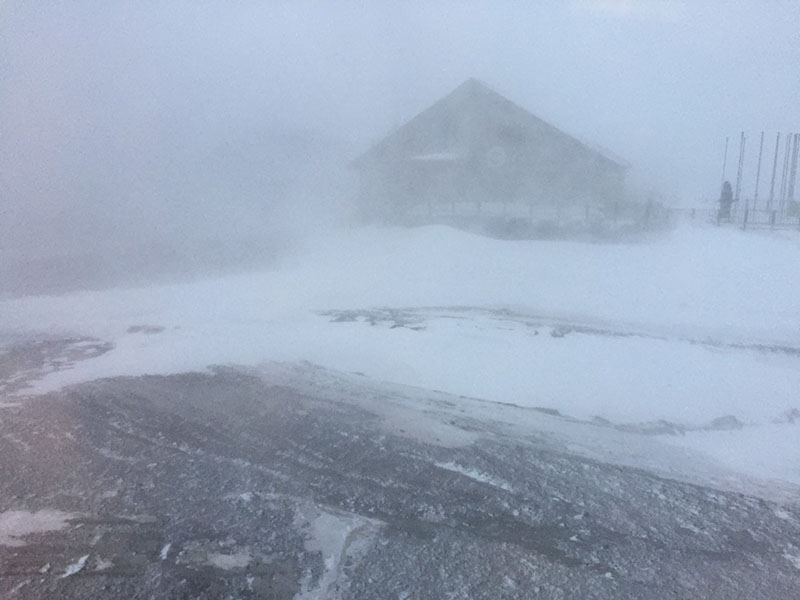
Photo Credit: Natalie Caro
The Chalet barely stands out against the blowing snow during a brief, relative lull in the worst of the stormy conditions in September.
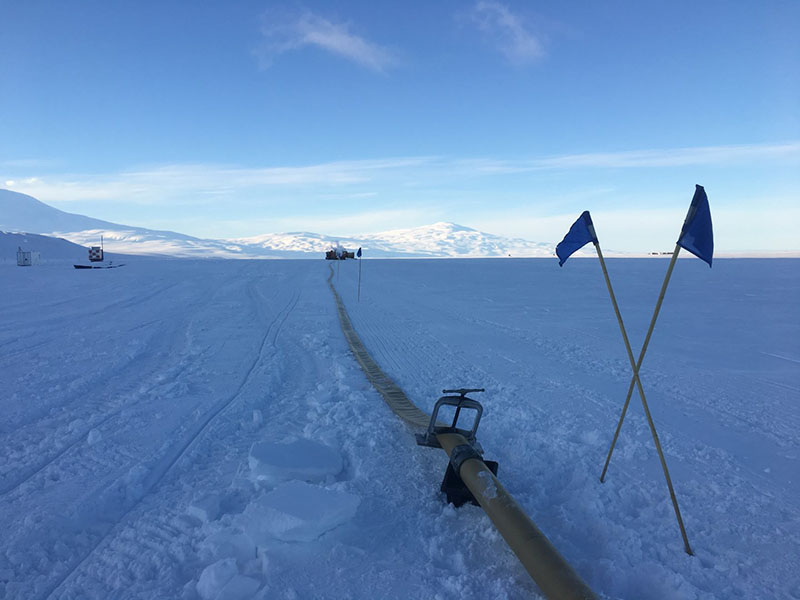
Photo Credit: Levi Liston
In preparation for the start of Mainbody, fuelies lay out long fuel lines to the airfields.
The month before Mainbody is usually a busy one at McMurdo, and this year was no exception. After the initial flurry of activity and adjustment to a dramatically increased station population following the first couple of flights at the end of August, station residents got down to the task of preparing for the frenetic pace of the coming summer season.
With several science groups planning to arrive in the first week of October, Field Safety and Training personnel got right to work prepping travel routes on the sea ice of McMurdo Sound, which these groups will use in conducting their research. The team members worked tirelessly day-in and day-out to mark, flag and establish routes in weather ranging from bluebird skies to bitter wind and cold.
Various other preparatory projects continued apace during September, with helicopters being readied for early flight operations, Fleet Operations continuing construction on moving Williams Airfield in time to support ski aircraft during the summer, and the fuels department laying hoses from town to the airfields for Mainbody flight operations.
However, September was not without its moments of pique. After the unexpected calm during Winfly flight operations, the weather in McMurdo reasserted itself with force, resulting in several days of intermittent Condition 1 on station, the most severe weather classification. While disruptive to operations, this is nevertheless a moment of great interest to both newcomers and old-timers alike, given the uniqueness and intensity of these weather events.
As always, the prelude to summer for some means the denouement to winter for others and a time to return home. For the former, it means easing into the pace and way of life at McMurdo, for some of whom it may be the first time and replete with a sense of wonder and adventure that often accompanies a first trip to the Ice. For the latter, it means goodbyes (some temporary, some less so), but also the prospect of vacation, a return home, greenery and new adventures in the world beyond the Ice.
The Flights of Winfly
By Travis Senor, McMurdo Station correspondent
September 13, 2018

Photo Credit: Steven Windsor
Seen behind a cargo Delta, the sun is just visible peeking over the horizon.

Photo Credit: Travis Senor
The radome on Arrival Heights stands out in contrast to the Iridescent nacreous clouds overhead, a unique feature to early polar springs.

Photo Credit: Travis Senor
Iridescent nacreous clouds light up the sky over McMurdo Station.
August usually means two things at McMurdo: Winfly and weather, the latter usually of the poor variety and greatly impacting the former. However, this year that was very much not the case, in stark contrast to the same time last year. Continuing a trend of mild weather that's lasted all winter, August proved to be little different, apart from some expected low temperatures and unexpected stretches of little-to-no wind.
Despite the sun finally arriving back at McMurdo only a few days prior, temperatures for Winfly flight operations were decidedly on the chilly side of things, with the mercury at Phoenix Airfield hovering in the -50 degrees Fahrenheit range, but the weather was notable for the distinct lack of wind. After only a single day of delays, all four Winfly flights came and went in a flurry of back-to-back-to-back-to-back activity across a 48-hour span. Flight support crews pulled long days in these low temperatures to make sure operations came off without a hitch, and this year’s expedited flight tempo could not have been realized without them.
However, those who left at Winfly, to say nothing of the winter crew who would remain behind, were treated to a spectacular display of nacreous clouds on the near-eve of their departure. Over several days prior to scheduled flights, the sky above McMurdo was awash in colorful cloud formations that call to mind iridescent oil paintings or the impression of a sky on fire. These stratospheric clouds are exceedingly rare and found only in the Earth’s Polar Regions due to the very low temperatures required for them to form. As beautiful as they are, however, these clouds are not without their downsides as their presence supports chemical reactions which lead to ozone depletion.
And as always, Winfly is a time for both greetings and goodbyes, with friends leaving for warmer climes and faces old and new arriving on station. The pace of life on station picks up noticeably, which can be jarring to some who are used to the quieter pace of winter, but to many the fresh energy and enthusiasm is a welcome jolt, and helps carry McMurdo along on the march toward Mainbody, and the surge of scientific activity that comes with it.
Christmas in July
By Elizabeth Delaquess, McMurdo Station correspondent
August 3, 2018
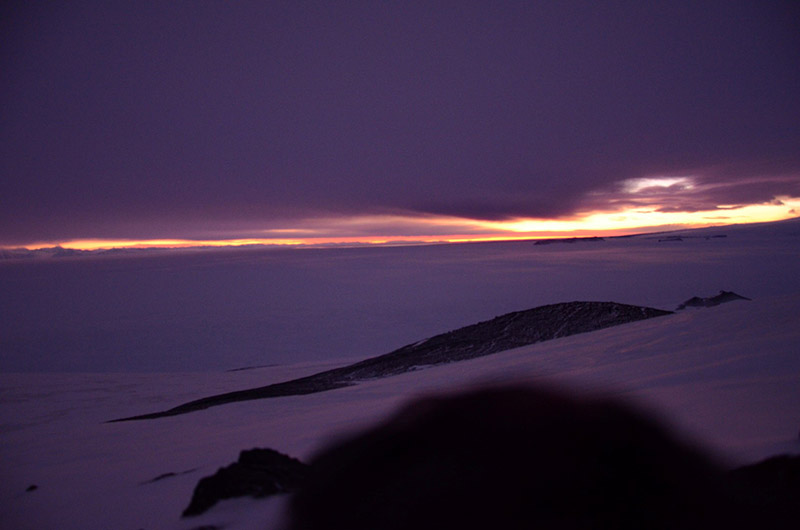
Photo Credit: Elizabeth Delaquess
Though the sun hasn’t yet crested the horizon, the orange and purple glow along the eastern horizon herald the forthcoming end of the months-long Antarctic night.
July was a month of transition at McMurdo Station. The station got its first flight in over three months, bringing much-anticipated mail and fresh vegetables. Then, near the end of the month, the very first touches of light as the sun slowly crept towards the horizon.
The month started out dark as night and with the lowest temperatures the station had experienced all year. Ambient temperatures dipped to 40 below zero Fahrenheit and wind chills reached 80 below zero Fahrenheit. Aurora sightings remained fairly infrequent this year, but folks receiving aurora alert pages from the firehouse have seen some good displays, especially around New Zealand’s Scott Base.
The cold didn’t stop McMurdo residents from organizing the 3rd annual Independence Day parade. The event took place at noon and lasted just ten minutes, but many people pitched in to create a parade full of uniquely McMurdo-style quirkiness. A five-person marching band, a veteran’s group, a tutu color guard and the giant model orca from Midwinter dinner were some of the features of this year’s parade.
The midwinter flight, originally scheduled to arrive at the end of June, was delayed three weeks due to mechanical issues. This extended delay made the arrival of fresh vegetables, fruit and mail on July 19th all the more special. On the flight day, many people volunteered to help with cargo offloading and processing, as jobs that would be covered in the summer require volunteer assistance from winter contractors due to the station’s low population. A day after the flight arrived and departed, taking 24 people back to Christchurch and bringing in 25 new folks, McMurdo Station was buzzing with excitement. There was a line of people in the mailroom building eagerly collecting their packages, people were grinning in the galley at the sight of fresh lettuce and tomatoes and the energy provided by new contractors all combined to make it feel like Christmas in July. Many of the folks who arrived on this flight are on station for just a few months to help wrap up winter construction projects before the summer season begins, but there are also a number of folks who will be here through next summer, if not longer.
The other excitement for July was watching the sunlight slowly creep above the Royal Society Range. The sun won’t fully rise until August 19th, but as the month has worn on, the sun has gotten close enough to the horizon to make the mountains faintly visible once again as the eastern horizon turn gold, pink, and red for several hours in the middle of the afternoon. Those few hours of pink skies and deep blue twilight have been a much-needed reminder for the winter crew that sunlight will be returning soon.
Overcoming the Challenges of Midwinter
By Elizabeth Delaquess, McMurdo Station correspondent
July 27, 2018

Photo Credit: Elizabeth Delaquess
In keeping with the theme of "Under the Sea," station resident erected a fabric orca in the cafeteria for the station's annual Midwinter Dinner.

Photo Credit: Elizabeth Delaquess
Midwinters Greetings from stations across the continent adorn the wall leading up to the cafeteria.
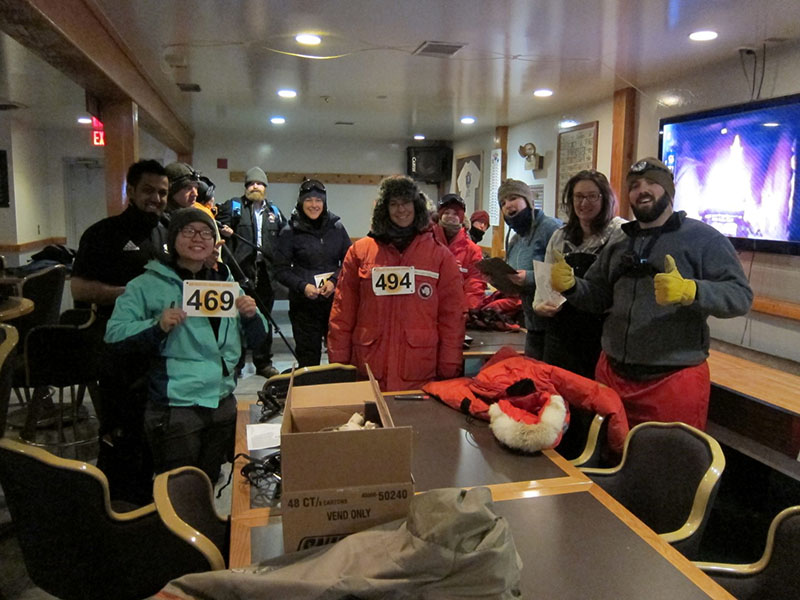
Photo Credit: Elizabeth Delaquess
Station residents prepare for the annual "Midwinter Mile" run around the station.
June at McMurdo Station was a time of challenges and celebrations. Personnel celebrated Midwinter with the annual Midwinter Dinner and other events while also juggling the challenges that come with maintaining aging infrastructure in an extreme and isolated environment.
A large glycol leak occurred in the cafeteria just a few days before Midwinter Dinner, temporarily delaying meal preparations. In response, many members of the community pitched in and helped with clean up and dinner prep so McMurdo's Midwinter Dinner took place on time with no issues. Turnout was excellent, and dozens of people donated their free time to setting up and decorating. The theme this year was “Under the Sea,” and decorations in the galley included videos from the McMurdo Oceanographic Observatory, the underwater camera installed near the end of the summer season, and a 15-foot-long orca that the waste department built from used cardboard boxes and fabric.
As well as McMurdo's dinner, a number of station residents attended Midwinter celebrations at New Zealand’s Scott Base. As stations all around the continent sent out Midwinter greetings, it was a special treat to celebrate this uniquely Antarctic holiday people from another Antarctic research program. Scott Base’s cafeteria was similarly well-decorated, and culinary staff from McMurdo assisted in food preparation there.
Midwinter celebration continued the next day with the annual “Midwinter Mile,” a one-mile race around McMurdo station. Participants braved 30-mile-an-hour winds and minus 18-degree Fahrenheit temperatures to participate in “the shortest, darkest race on the shortest, darkest day.”
As well as the joy and sense of community that comes with Midwinter celebrations, station residents have been gracefully handling other unexpected challenges that have come up in the last month. The furnace in the big gym has been down for several weeks, making recreation there impossible. The boiler replacement project in dorm 208 has made the library inaccessible all winter, and in mid-June, the TV station lost prime time, sports, and news programming it receives from the American Forces Network due to a satellite change. However, folks have been making do in their free time with jigsaw puzzles in the galley, activities in other gyms and even some access to World Cup matches with the temporary addition of a web streaming service in a lounge area.
Despite these challenges, most people have been staying busy and happy. At this point in the season, many wintering workers start longing for mail and fresh vegetables but also take time to reflect on the magic of working in Antarctica and celebrating community during the coldest, darkest, and most isolating time of the year.
Eyes on the Skies
By Elizabeth Delaquess, McMurdo Station correspondent
May 30, 2018
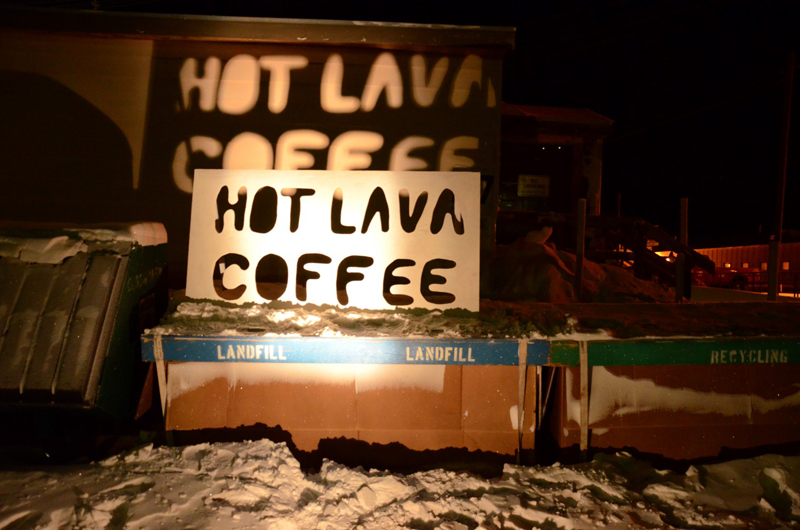
Photo Credit: Elizabeth Delaquess
Station residents work hard throughout the dark winter months. On Sunday mornings, residents like to get together and kick back with a hot cup of “Lava Coffee.” Sign made by David Forrest.
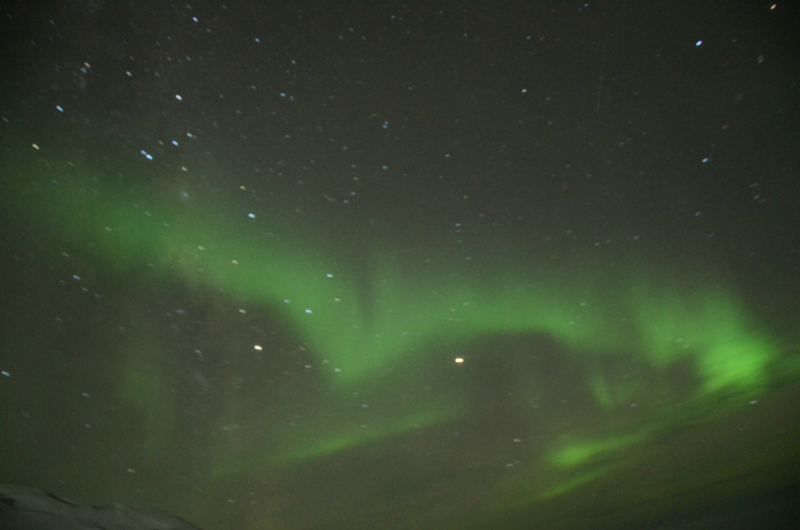
Photo Credit: Elizabeth Delaquess
In the darkness of winter, a shimmering band of the aurora australis glows over the road to Scott Base.
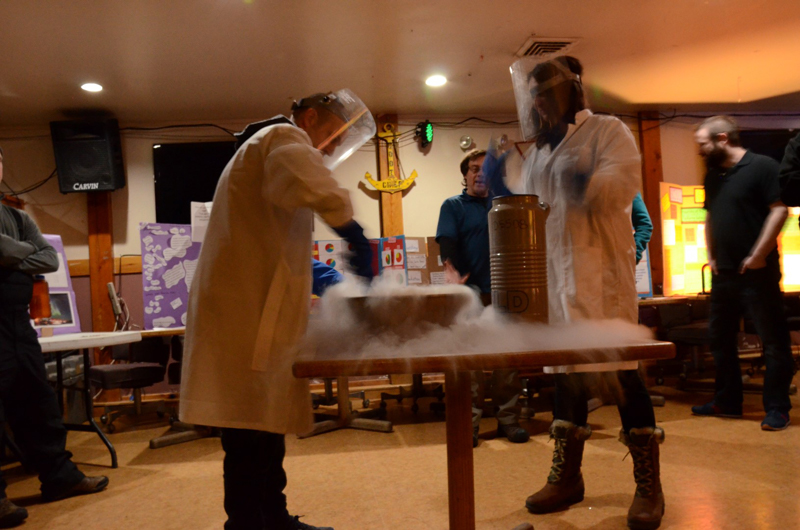
Photo Credit: Elizabeth Delaquess
For the station’s science fair, Matt Kehler (left) and Liz Widen make sorbet using liquid nitrogen.
May was a quiet month at McMurdo Station. The “shoulder season” of the prior few months was a time for many transitions as the daylight changed and March and April flights brought contractors to and from the Ice. But there were no flights in May, and McMurdo’s population of 133 remained settled in its work and activities for winter.
Winter projects have been continuing as planned. Supply centers have finished all vessel and air shipment receiving, processing more than 24,000 items, and have also begun planning for the flight at the end of June, which will bring in a lot of cargo. Facilities and construction staff are making progress on replacing the boiler in Dorm 208, a big enough project to close the library for the entire winter.
The few hours of twilight McMurdo experienced at the beginning of the month have been replaced by total darkness, all day, with the moon and stars easily visible in the middle of the day in clear weather. McMurdo is experiencing a quiet year for auroras so far, with only a few aurora alert pages sent from the firehouse. Nevertheless, McMurdo residents were treated to a few good aurora sightings this month, especially on the road between McMurdo and Scott Base. Winter-travel safety regulations and fewer out-of-town recreation opportunities than in summer make getting away from light pollution tricky, but folks lucky enough to get outside of town at the right time have seen some small but beautiful auroras.
Some special events for the station this month included the launch of NASA’s GRACE follow-on satellite, a satellite that will use gravity to track groundwater changes around the earth and provide invaluable climate change data. NASA’s Ground Station at McMurdo is a crucial component in tracking satellites, and the GRACE follow-on launch on May 23rd kept the two McMurdo Ground Station engineers extra busy. McMurdo was the first station to receive data from the satellite on its first orbit over Antarctica, and will continue to track the satellite for the next five years.
Another highlight of the month was the annual winter science fair. Turnout was excellent this year, with almost half the station, as well as many folks from Scott Base, enjoying more than a dozen science projects put together by community members in their free time. Some science projects were more serious, like using liquid nitrogen to make sorbet in five minutes, and a photography experiment that measured how often people need to have their photo taken before they get one they like. Some were more lighthearted, like a survey that asked people how they like their eggs cooked in the galley, and what are the most common names on station.
Based on the progress being shown on large winter projects and the number of recreation activities that residents are organizing in their free time, May has proven to be another productive and enjoyable month in the long McMurdo winter season.
Last Rays of a Setting Sun
By Elizabeth Delaquess, McMurdo Station correspondent
May 3, 2018

Photo Credit: Elizabeth Delaquess
Elizabeth Delaquess reads a book in the “light room” set up inside the main building to help residents cope with months of unbroken darkness.

Photo Credit: Elizabeth Delaquess
A small crowd of people watch the last sunset until mid-August from Arrival Heights, a ridge overlooking McMurdo Station.
Winter fully settled in at McMurdo Station in April. A flight brought the station’s population to its lowest of the season, the sun rose for the last time until August and McMurdo residents, most of whom will be here for another four to six months, are diving further into their winter duties.
The April flight departed with no delays on the 16th, reducing the station’s population to 133, where it will remain, roughly, until the August flights begin and the station will more than double in population. The incoming flight brought some mail but no fresh vegetables, meaning McMurdo residents won’t have a fresh salad until the end of June, when a cargo flight is scheduled to arrive.
With such a small population, shared spaces like the galley feel much more relaxed, and have helped foster a more family like atmosphere in the last month. Now that the transitional months of February and March are over, McMurdo residents are hard at work on winter projects and pursuing recreational activities during their time off. Science lectures or TV shows can be enjoyed in the Crary lab’s library every week on “Science!!! Monday,” a dorm room in building 155 has been temporarily turned into a “light room” with couches and fake plants to help residents handle the lack of natural light over the next several months, and the firehouse has created an aurora watch pager list to alert folks anytime an aurora is spotted.
Trips to Arrival Heights and Phoenix Airfield were organized at the end of the month to see the last sunsets. The sun rose and then set one hour later on April 24. By the end of the month, the only daylight that came to McMurdo was a few hours of twilight in the middle of the day. Wildlife hasn’t been seen near McMurdo in a month, and safety ropes running between 155 and the dorms have been set up in preparation for severe winter storms.
The wildlife of Antarctica may be settling in to winter hibernation, but station operations and maintenance continue as planned. Progress has been made on the boiler upgrade in dorm 208, and a five-person traverse out to the telecommunications facilities at nearby Black Island to carry out repairs was completed successfully. Otherwise, most projects taking place over the winter focus on station repair and upkeep before another busy summer season gets underway.
With colder temperatures, almost total darkness each day, and no fresh vegetables for another two months, McMurdo residents are ready for the long haul of winter in Antarctica.
Winter Settles In
By Elizabeth Delaquess, McMurdo Station correspondent
April 4, 2018
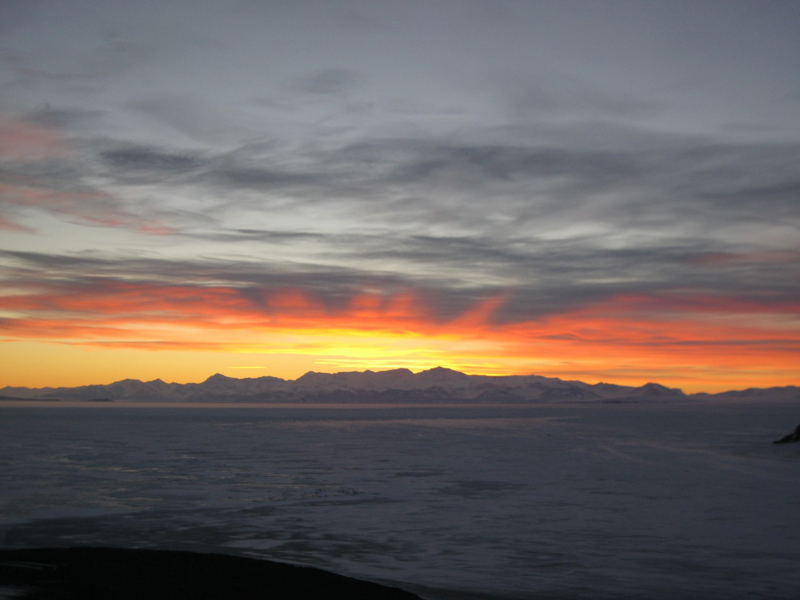
Photo Credit: Elizabeth Delaquess
The sun dips below the horizon. Each day gets progressively shorter until the five-month long night sets in for winter.

Photo Credit: Elizabeth Delaquess
At the "Skua Sorting Party", volunteers sort discarded items.
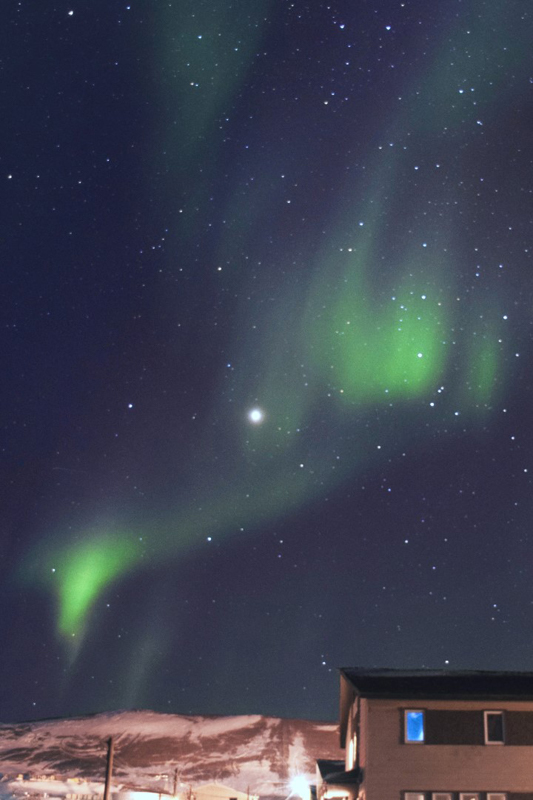
Photo Credit: Margot Cate
The first auroras of winter have been spotted over the station.
The "shoulder season" at McMurdo Station was underway through March. The last flight of summer left on February 27, bringing the station population down to 217. Personnel remaining at McMurdo in March spent the month working on end-of-season projects, enjoying the first sunsets and dark night skies in months and beginning station-wide winter activities.
Members of the New Zealand Defense Force (NZDF), which arrived at McMurdo at the beginning of February, spent the month working on a number of projects for the station. These included refurbishing one of the dorms, dismantling, inspecting, and rebuilding the ice pier’s Bailey bridge used during vessel operations, and assisting in supply and other work centers. In addition to end-of-season work by the NZDF, a few mechanics and carpenters remained after the summer crowds left to work on laying cable for telecommunications upgrades and winterizing dorms. All but three of the dorms, as well as the coffeehouse, are being closed for the winter.
The first winter flight departed March 17th, taking 57 contractors back to Christchurch and bringing the station population down to 171. Following the departure of the March flight, McMurdo Station residents held our first big winter season event: The annual "skua sorting" party. Turnout was excellent this year, with about 35 volunteers sorting trash, recycling, and unwanted clothes, shoes, art supplies, and other articles from 18 huge cardboard containers in just a few hours. Items not thrown away, claimed for personal use, or sent to the Berg Field Center and Lodging went to "Skua Central," McMurdo’s free clothing and supply center.
McMurdo residents also began enjoying occasional dinners at New Zealand’s Scott Base. The Kiwi station’s winter population of just 15 allows eight or so McMurdo residents to join them for dinner before "American Night," a tradition that runs all year, but enjoys a quietness and intimacy only found in the winter season.
Science activity slowed down considerably, with just two grantees remaining for the winter to conduct atmospheric research at Arrival Heights, at the edge of town. Work installing and adjusting a meteor radar and antenna array between McMurdo and Scott Base was also completed in March. Numerous summer research projects receive support and maintenance over the winter at Crary Lab, but there is no fieldwork being performed over the winter at McMurdo Station.
March is one of only two months per year where McMurdo residents are treated to equal parts daylight and darkness. Many people could be seen hiking down to Hut Point to view the sunsets and sunrises over the Transantarctic Mountains, and the first stars and auroras were captured by photographers willing to venture out in the middle of the night. The Berg Field Center began organizing Winterover Survival Training classes, and winter travel rules were put in effect, restricting solo travel and requiring extra safety precautions when using trails around the station.
With a shrinking town population, shoulder season maintenance projects wrapping up, science activity slowing down and the dark skies arriving ten minutes earlier every night, winter is quickly getting underway at McMurdo Station.
Shifting From Summer to Winter
By Elizabeth Delaquess, McMurdo Station correspondent
March 5, 2018

Photo Credit: Elizabeth Delaquess
As the sea ice broke up, Adelie penguins stopped by the shores near McMurdo Station.
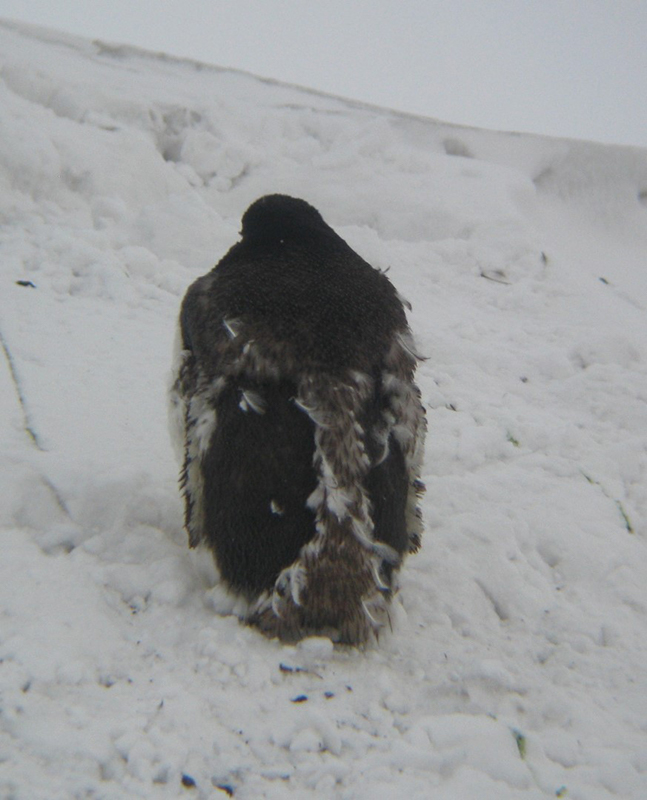
Photo Credit: Elizabeth Delaquess
A molting Adelie penguin stands on Ross island near McMurdo Station.

Photo Credit: Elizabeth Delaquess
The sun sinks below the Transantarctic Mountains. The first sunset of the year happened on February 20th.
February was a month of big transitions at McMurdo Station. It started with vessel operations and the majority of science activities wrapping up. It ended with the last C-17 flight of the busy summer season ("Mainbody") leaving a small winter population to finish the station’s metamorphosis into winter mode.
Activity peaked in late January. The cargo vessel offloaded supplies and loaded up on retrograde waste. The town’s population swelled to over 900 people with the addition of personnel to assist with the cargo ship Ocean Giant. In early February the last supply vessel, the fuel tanker Maersk Perry, arrived at the ice pier. The Perry kept McMurdo’s fuels department busy delivering needed fuel for the next year, until it departed with the U.S. Coast Guard icebreaker Polar Star several days later, bringing this season’s vessel operations to an end.
The beginning of February also marked the end of "the gap," a period from around early December until early February when the white ice runway at Phoenix Airfield, the airfield used by the C-17 airplanes, becomes unusable due to warmer temperatures. During this time, the flow of nonessential cargo like package mail and fresh vegetables, known as "freshies," slows to a trickle. The return of the C-17s meant freshies in the galley and mail for the first time in several weeks. It also marked the start of the mass exodus that begins in early February and culminates at the end of the month. Nearly all of the science groups wrapped up their work in early February, with support staff remaining in larger camps like Shackleton Glacier until mid-month. Carpenters, electricians and communications technicians were flown out to the field to take down camp infrastructure, and science cargo was packed up and shipped off continent.
Bad weather has been a feature of the summer season this year, though there were some beautiful days early in the month that allowed McMurdo Station personnel to get out and enjoy the area. February was a great month for viewing wildlife. Weddell seals, which would often rest along the cracks in the sea ice during the summer, became less common as the month drew on. But at the beginning of February, when it was warmer, Minke and orca whales were sometimes seen in a large patch of open water along the Ob Hill Loop trail, about a half mile from the station. A few emperor penguins were spotted in the area and Adelie penguins were often seen near Hut Point, with a half dozen or so coming onto Ross Island to molt.
McMurdo had its first sunset in four months on February 20th, and a week later, the final Mainbody flight took off. On the last day of February, we still had over 20 hours of daylight, and it didn’t look like winter quite yet. Although we had midnight sun and some nice weather near the beginning of the month, February went out like a lion¬. Fierce winds, frigid temperatures and the return of the sunsets were a good reminder to departing and arriving Antarcticans alike that winter is just around the corner.
Holidays Around McMurdo
By Nicolette Ratz, McMurdo Station correspondent
January 26, 2018

Photo Credit: Mike Lucibella
A waddle of penguins that passed by the station on Christmas Day.
The ocean creeps towards us: a thin strip along the horizon soon to be an expanse of blue butting up against our shore. The coastal ice buckles and pockets of water give way to recently submerged penguins looking for a warm nap upon the sea ice; they shake off and stretch their wings. Sitting atop Hut Point, one can see dozens of Weddell seals at rest, a handful of Adelie penguins waddling along, occasionally sliding on their bellies, while a South Polar Skua – a seabird related to the North American jaeger – swoops in to bathe in a nearby puddle. The sun illuminates the mountains of the Royal Society Range across miles of sea ice. There is nothing overtly wild about the life that surrounds McMurdo; even in the midst of dominance fights between male seals, the ecosystem is full, active, and unafraid of our gaze.
Poetics aside, this month was full of activity – inside and out.
The beginning of December kicked off with the annual Craft Show. It brought out McMurdo’s knitters, woodworkers, screen printers and artists. One of the most popular items was a T-shirt with the face of "Shuttle Bob." The shuttle driver has seen eleven seasons here at McMurdo and this year will be his last. The shirt is a fitting commemorative as he was likely the first to drop many off at their new dorm their first season, as he did for me.
For the athletic, there were no shortages of challenges. They consisted of two runs: the Ob Hill Uphill (a dash to the top of our local, steep hill) and the annual 10K. There was also the Man Haul: a tradition honoring Captain Robert Falcon Scott and his crew in the early 1900s, who – among others in that period – pulled their own sleds of gear by rope, similar to sled dogs. The strains of "manhauling" unfortunately contributed to the deaths of Scott and his party on their return from the South Pole . Today, the task is revived as a friendly challenge between McMurdo Station and New Zealand’s Scott Base.
During the week before the holidays the Waste department hosted a show typically known as the "Waste Barn Party." Crates, machinery, tools, and other work-related items were stored elsewhere while the employees and community members set up a stage, placed couches and chairs, and decorated the place to a wonderfully unrecognizable degree; we at once stepped out of the cold and into some warm, homey entertainment. Fellow coworkers sang, flipped and bent and impressed many in acrobatic yoga, collaborated to make festive tunes and beckoned laughter from the crowd. Oh – and we can’t forget about The Monotones: McMurdo’s one-note singing wonders.
For Christmas, the creative enthusiastically worked on projects for several contests. Flags were decorated and hung; gingerbread construction took the look of field camp tents and local McMurdo buildings; and a handful of hopeful contestants battled it out for a shot at being Santa at the big Christmas Party.
Even as I pack this update full of activities, there are still some missing. For a small isolated group of humans, McMurdo residents sure know how to keep spirits high. Here, the weather continues to warm as our fellow Americans back home experience uncommonly cold weather. To them, ironically, I say, "stay warm."
Station News Home Page



























